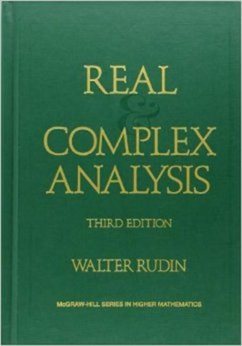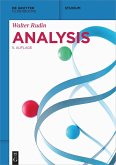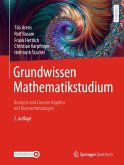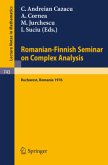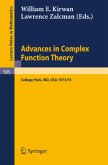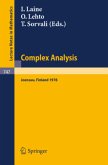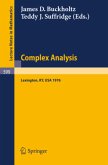Walter Rudin
Real and Complex Analysis
Walter Rudin
Real and Complex Analysis
- Gebundenes Buch
- Merkliste
- Auf die Merkliste
- Bewerten Bewerten
- Teilen
- Produkt teilen
- Produkterinnerung
- Produkterinnerung
This is an advanced text for the one- or two-semester course in analysis taught primarily to math, science, computer science, and electrical engineering majors at the junior, senior or graduate level. The basic techniques and theorems of analysis are presented in such a way that the intimate connections between its various branches are strongly emphasized. The traditionally separate subjects of 'real analysis' and 'complex analysis' are thus united in one volume. Some of the basic ideas from functional analysis are also included. This is the only book to take this unique approach. The third…mehr
Andere Kunden interessierten sich auch für
![Analysis Analysis]() Walter RudinAnalysis46,95 €
Walter RudinAnalysis46,95 €![Grundwissen Mathematikstudium - Analysis und Lineare Algebra mit Querverbindungen Grundwissen Mathematikstudium - Analysis und Lineare Algebra mit Querverbindungen]() Tilo ArensGrundwissen Mathematikstudium - Analysis und Lineare Algebra mit Querverbindungen64,99 €
Tilo ArensGrundwissen Mathematikstudium - Analysis und Lineare Algebra mit Querverbindungen64,99 €![Romanian-Finnish Seminar on Complex Analysis Romanian-Finnish Seminar on Complex Analysis]() Romanian-Finnish Seminar on Complex Analysis42,99 €
Romanian-Finnish Seminar on Complex Analysis42,99 €![Advances in Complex Function Theory Advances in Complex Function Theory]() Advances in Complex Function Theory30,99 €
Advances in Complex Function Theory30,99 €![Complex Analysis. Joensuu 1978 Complex Analysis. Joensuu 1978]() Complex Analysis. Joensuu 197838,99 €
Complex Analysis. Joensuu 197838,99 €![Real Analysis for the Undergraduate Real Analysis for the Undergraduate]() Matthew A. PonsReal Analysis for the Undergraduate37,99 €
Matthew A. PonsReal Analysis for the Undergraduate37,99 €![Complex Analysis. Kentucky 1976 Complex Analysis. Kentucky 1976]() Complex Analysis. Kentucky 197621,99 €
Complex Analysis. Kentucky 197621,99 €-
-
-
This is an advanced text for the one- or two-semester course in analysis taught primarily to math, science, computer science, and electrical engineering majors at the junior, senior or graduate level. The basic techniques and theorems of analysis are presented in such a way that the intimate connections between its various branches are strongly emphasized. The traditionally separate subjects of 'real analysis' and 'complex analysis' are thus united in one volume. Some of the basic ideas from functional analysis are also included. This is the only book to take this unique approach. The third edition includes a new chapter on differentiation. Proofs of theorems presented in the book are concise and complete and many challenging exercises appear at the end of each chapter. The book is arranged so that each chapter builds upon the other, giving students a gradual understanding of the subject. This text is part of the Walter Rudin Student Series in Advanced Mathematics.
Hinweis: Dieser Artikel kann nur an eine deutsche Lieferadresse ausgeliefert werden.
Hinweis: Dieser Artikel kann nur an eine deutsche Lieferadresse ausgeliefert werden.
Produktdetails
- Produktdetails
- Verlag: McGraw Hill LLC
- 3rd Revised edition
- Seitenzahl: 432
- Erscheinungstermin: 1. Mai 1986
- Englisch
- Abmessung: 242mm x 170mm x 29mm
- Gewicht: 771g
- ISBN-13: 9780070542341
- ISBN-10: 0070542341
- Artikelnr.: 22168419
- Herstellerkennzeichnung
- Libri GmbH
- Europaallee 1
- 36244 Bad Hersfeld
- gpsr@libri.de
- Verlag: McGraw Hill LLC
- 3rd Revised edition
- Seitenzahl: 432
- Erscheinungstermin: 1. Mai 1986
- Englisch
- Abmessung: 242mm x 170mm x 29mm
- Gewicht: 771g
- ISBN-13: 9780070542341
- ISBN-10: 0070542341
- Artikelnr.: 22168419
- Herstellerkennzeichnung
- Libri GmbH
- Europaallee 1
- 36244 Bad Hersfeld
- gpsr@libri.de
Preface
Prologue: The Exponential Function
Chapter 1: Abstract Integration
Set-theoretic notations and terminology
The concept of measurability
Simple functions
Elementary properties of measures
Arithmetic in [0, 8]
Integration of positive functions
Integration of complex functions
The role played by sets of measure zero
Exercises
Chapter 2: Positive Borel Measures
Vector spaces
Topological preliminaries
The Riesz representation theorem
Regularity properties of Borel measures
Lebesgue measure
Continuity properties of measurable functions
Exercises
Chapter 3: Lp-Spaces
Convex functions and inequalities
The Lp-spaces
Approximation by continuous functions
Exercises
Chapter 4: Elementary Hilbert Space Theory
Inner products and linear functionals
Orthonormal sets
Trigonometric series
Exercises
Chapter 5: Examples of Banach Space Techniques
Banach spaces
Consequences of Baire's theorem
Fourier series of continuous functions
Fourier coefficients of L1-functions
The Hahn-Banach theorem
An abstract approach to the Poisson integral
Exercises
Chapter 6: Complex Measures
Total variation
Absolute continuity
Consequences of the Radon-Nikodym theorem
Bounded linear functionals on Lp
The Riesz representation theorem
Exercises
Chapter 7: Differentiation
Derivatives of measures
The fundamental theorem of Calculus
Differentiable transformations
Exercises
Chapter 8: Integration on Product Spaces
Measurability on cartesian products
Product measures
The Fubini theorem
Completion of product measures
Convolutions
Distribution functions
Exercises
Chapter 9: Fourier Transforms
Formal properties
The inversion theorem
The Plancherel theorem
The Banach algebra L1
Exercises
Chapter 10: Elementary Properties of Holomorphic Functions
Complex differentiation
Integration over paths
The local Cauchy theorem
The power series representation
The open mapping theorem
The global Cauchy theorem
The calculus of residues
Exercises
Chapter 11: Harmonic Functions
The Cauchy-Riemann equations
The Poisson integral
The mean value property
Boundary behavior of Poisson integrals
Representation theorems
Exercises
Chapter 12: The Maximum Modulus Principle
Introduction
The Schwarz lemma
The Phragmen-Lindelöf method
An interpolation theorem
A converse of the maximum modulus theorem
Exercises
Chapter 13: Approximation by Rational Functions
Preparation
Runge's theorem
The Mittag-Leffler theorem
Simply connected regions
Exercises
Chapter 14: Conformal Mapping
Preservation of angles
Linear fractional transformations
Normal families
The Riemann mapping theorem
The class L
Continuity at the boundary
Conformal mapping of an annulus
Exercises
Chapter 15: Zeros of Holomorphic Functions
Infinite Products
The Weierstrass factorization theorem
An interpolation problem
Jensen's formula
Blaschke products
The Müntz-Szas theorem
Exercises
Chapter 16: Analytic Continuation
Regular points and singular points
Continuation along curves
The monodromy theorem
Construction of a modular function
The Picard theorem
Exercises
Chapter 17: Hp-Spaces
Subharmonic functions
The spaces Hp and N
The theorem of F. and M. Riesz
Factorization theorems
The shift operator
Conjugate functions
Exercises
Chapter 18: Elementary Theory of Banach Algebras
Introduction
The invertible elements
Ideals and homomorphisms
Applications
Exercises
Chapter 19: Holomorphic Fourier Transforms
Introduction
Two theorems of Paley and Wiener
Quasi-analytic classes
The Denjoy-Carleman theorem
Exercises
Chapter 20: Uniform Approximation by Polynomials
Introduction
Some lemmas
Mergelyan's theorem
Exercises
Appendix: Hausdorff's Maximality Theorem
Notes and Comments
Bibliography
List of Special Symbols
Index
Prologue: The Exponential Function
Chapter 1: Abstract Integration
Set-theoretic notations and terminology
The concept of measurability
Simple functions
Elementary properties of measures
Arithmetic in [0, 8]
Integration of positive functions
Integration of complex functions
The role played by sets of measure zero
Exercises
Chapter 2: Positive Borel Measures
Vector spaces
Topological preliminaries
The Riesz representation theorem
Regularity properties of Borel measures
Lebesgue measure
Continuity properties of measurable functions
Exercises
Chapter 3: Lp-Spaces
Convex functions and inequalities
The Lp-spaces
Approximation by continuous functions
Exercises
Chapter 4: Elementary Hilbert Space Theory
Inner products and linear functionals
Orthonormal sets
Trigonometric series
Exercises
Chapter 5: Examples of Banach Space Techniques
Banach spaces
Consequences of Baire's theorem
Fourier series of continuous functions
Fourier coefficients of L1-functions
The Hahn-Banach theorem
An abstract approach to the Poisson integral
Exercises
Chapter 6: Complex Measures
Total variation
Absolute continuity
Consequences of the Radon-Nikodym theorem
Bounded linear functionals on Lp
The Riesz representation theorem
Exercises
Chapter 7: Differentiation
Derivatives of measures
The fundamental theorem of Calculus
Differentiable transformations
Exercises
Chapter 8: Integration on Product Spaces
Measurability on cartesian products
Product measures
The Fubini theorem
Completion of product measures
Convolutions
Distribution functions
Exercises
Chapter 9: Fourier Transforms
Formal properties
The inversion theorem
The Plancherel theorem
The Banach algebra L1
Exercises
Chapter 10: Elementary Properties of Holomorphic Functions
Complex differentiation
Integration over paths
The local Cauchy theorem
The power series representation
The open mapping theorem
The global Cauchy theorem
The calculus of residues
Exercises
Chapter 11: Harmonic Functions
The Cauchy-Riemann equations
The Poisson integral
The mean value property
Boundary behavior of Poisson integrals
Representation theorems
Exercises
Chapter 12: The Maximum Modulus Principle
Introduction
The Schwarz lemma
The Phragmen-Lindelöf method
An interpolation theorem
A converse of the maximum modulus theorem
Exercises
Chapter 13: Approximation by Rational Functions
Preparation
Runge's theorem
The Mittag-Leffler theorem
Simply connected regions
Exercises
Chapter 14: Conformal Mapping
Preservation of angles
Linear fractional transformations
Normal families
The Riemann mapping theorem
The class L
Continuity at the boundary
Conformal mapping of an annulus
Exercises
Chapter 15: Zeros of Holomorphic Functions
Infinite Products
The Weierstrass factorization theorem
An interpolation problem
Jensen's formula
Blaschke products
The Müntz-Szas theorem
Exercises
Chapter 16: Analytic Continuation
Regular points and singular points
Continuation along curves
The monodromy theorem
Construction of a modular function
The Picard theorem
Exercises
Chapter 17: Hp-Spaces
Subharmonic functions
The spaces Hp and N
The theorem of F. and M. Riesz
Factorization theorems
The shift operator
Conjugate functions
Exercises
Chapter 18: Elementary Theory of Banach Algebras
Introduction
The invertible elements
Ideals and homomorphisms
Applications
Exercises
Chapter 19: Holomorphic Fourier Transforms
Introduction
Two theorems of Paley and Wiener
Quasi-analytic classes
The Denjoy-Carleman theorem
Exercises
Chapter 20: Uniform Approximation by Polynomials
Introduction
Some lemmas
Mergelyan's theorem
Exercises
Appendix: Hausdorff's Maximality Theorem
Notes and Comments
Bibliography
List of Special Symbols
Index
Preface
Prologue: The Exponential Function
Chapter 1: Abstract Integration
Set-theoretic notations and terminology
The concept of measurability
Simple functions
Elementary properties of measures
Arithmetic in [0, 8]
Integration of positive functions
Integration of complex functions
The role played by sets of measure zero
Exercises
Chapter 2: Positive Borel Measures
Vector spaces
Topological preliminaries
The Riesz representation theorem
Regularity properties of Borel measures
Lebesgue measure
Continuity properties of measurable functions
Exercises
Chapter 3: Lp-Spaces
Convex functions and inequalities
The Lp-spaces
Approximation by continuous functions
Exercises
Chapter 4: Elementary Hilbert Space Theory
Inner products and linear functionals
Orthonormal sets
Trigonometric series
Exercises
Chapter 5: Examples of Banach Space Techniques
Banach spaces
Consequences of Baire's theorem
Fourier series of continuous functions
Fourier coefficients of L1-functions
The Hahn-Banach theorem
An abstract approach to the Poisson integral
Exercises
Chapter 6: Complex Measures
Total variation
Absolute continuity
Consequences of the Radon-Nikodym theorem
Bounded linear functionals on Lp
The Riesz representation theorem
Exercises
Chapter 7: Differentiation
Derivatives of measures
The fundamental theorem of Calculus
Differentiable transformations
Exercises
Chapter 8: Integration on Product Spaces
Measurability on cartesian products
Product measures
The Fubini theorem
Completion of product measures
Convolutions
Distribution functions
Exercises
Chapter 9: Fourier Transforms
Formal properties
The inversion theorem
The Plancherel theorem
The Banach algebra L1
Exercises
Chapter 10: Elementary Properties of Holomorphic Functions
Complex differentiation
Integration over paths
The local Cauchy theorem
The power series representation
The open mapping theorem
The global Cauchy theorem
The calculus of residues
Exercises
Chapter 11: Harmonic Functions
The Cauchy-Riemann equations
The Poisson integral
The mean value property
Boundary behavior of Poisson integrals
Representation theorems
Exercises
Chapter 12: The Maximum Modulus Principle
Introduction
The Schwarz lemma
The Phragmen-Lindelöf method
An interpolation theorem
A converse of the maximum modulus theorem
Exercises
Chapter 13: Approximation by Rational Functions
Preparation
Runge's theorem
The Mittag-Leffler theorem
Simply connected regions
Exercises
Chapter 14: Conformal Mapping
Preservation of angles
Linear fractional transformations
Normal families
The Riemann mapping theorem
The class L
Continuity at the boundary
Conformal mapping of an annulus
Exercises
Chapter 15: Zeros of Holomorphic Functions
Infinite Products
The Weierstrass factorization theorem
An interpolation problem
Jensen's formula
Blaschke products
The Müntz-Szas theorem
Exercises
Chapter 16: Analytic Continuation
Regular points and singular points
Continuation along curves
The monodromy theorem
Construction of a modular function
The Picard theorem
Exercises
Chapter 17: Hp-Spaces
Subharmonic functions
The spaces Hp and N
The theorem of F. and M. Riesz
Factorization theorems
The shift operator
Conjugate functions
Exercises
Chapter 18: Elementary Theory of Banach Algebras
Introduction
The invertible elements
Ideals and homomorphisms
Applications
Exercises
Chapter 19: Holomorphic Fourier Transforms
Introduction
Two theorems of Paley and Wiener
Quasi-analytic classes
The Denjoy-Carleman theorem
Exercises
Chapter 20: Uniform Approximation by Polynomials
Introduction
Some lemmas
Mergelyan's theorem
Exercises
Appendix: Hausdorff's Maximality Theorem
Notes and Comments
Bibliography
List of Special Symbols
Index
Prologue: The Exponential Function
Chapter 1: Abstract Integration
Set-theoretic notations and terminology
The concept of measurability
Simple functions
Elementary properties of measures
Arithmetic in [0, 8]
Integration of positive functions
Integration of complex functions
The role played by sets of measure zero
Exercises
Chapter 2: Positive Borel Measures
Vector spaces
Topological preliminaries
The Riesz representation theorem
Regularity properties of Borel measures
Lebesgue measure
Continuity properties of measurable functions
Exercises
Chapter 3: Lp-Spaces
Convex functions and inequalities
The Lp-spaces
Approximation by continuous functions
Exercises
Chapter 4: Elementary Hilbert Space Theory
Inner products and linear functionals
Orthonormal sets
Trigonometric series
Exercises
Chapter 5: Examples of Banach Space Techniques
Banach spaces
Consequences of Baire's theorem
Fourier series of continuous functions
Fourier coefficients of L1-functions
The Hahn-Banach theorem
An abstract approach to the Poisson integral
Exercises
Chapter 6: Complex Measures
Total variation
Absolute continuity
Consequences of the Radon-Nikodym theorem
Bounded linear functionals on Lp
The Riesz representation theorem
Exercises
Chapter 7: Differentiation
Derivatives of measures
The fundamental theorem of Calculus
Differentiable transformations
Exercises
Chapter 8: Integration on Product Spaces
Measurability on cartesian products
Product measures
The Fubini theorem
Completion of product measures
Convolutions
Distribution functions
Exercises
Chapter 9: Fourier Transforms
Formal properties
The inversion theorem
The Plancherel theorem
The Banach algebra L1
Exercises
Chapter 10: Elementary Properties of Holomorphic Functions
Complex differentiation
Integration over paths
The local Cauchy theorem
The power series representation
The open mapping theorem
The global Cauchy theorem
The calculus of residues
Exercises
Chapter 11: Harmonic Functions
The Cauchy-Riemann equations
The Poisson integral
The mean value property
Boundary behavior of Poisson integrals
Representation theorems
Exercises
Chapter 12: The Maximum Modulus Principle
Introduction
The Schwarz lemma
The Phragmen-Lindelöf method
An interpolation theorem
A converse of the maximum modulus theorem
Exercises
Chapter 13: Approximation by Rational Functions
Preparation
Runge's theorem
The Mittag-Leffler theorem
Simply connected regions
Exercises
Chapter 14: Conformal Mapping
Preservation of angles
Linear fractional transformations
Normal families
The Riemann mapping theorem
The class L
Continuity at the boundary
Conformal mapping of an annulus
Exercises
Chapter 15: Zeros of Holomorphic Functions
Infinite Products
The Weierstrass factorization theorem
An interpolation problem
Jensen's formula
Blaschke products
The Müntz-Szas theorem
Exercises
Chapter 16: Analytic Continuation
Regular points and singular points
Continuation along curves
The monodromy theorem
Construction of a modular function
The Picard theorem
Exercises
Chapter 17: Hp-Spaces
Subharmonic functions
The spaces Hp and N
The theorem of F. and M. Riesz
Factorization theorems
The shift operator
Conjugate functions
Exercises
Chapter 18: Elementary Theory of Banach Algebras
Introduction
The invertible elements
Ideals and homomorphisms
Applications
Exercises
Chapter 19: Holomorphic Fourier Transforms
Introduction
Two theorems of Paley and Wiener
Quasi-analytic classes
The Denjoy-Carleman theorem
Exercises
Chapter 20: Uniform Approximation by Polynomials
Introduction
Some lemmas
Mergelyan's theorem
Exercises
Appendix: Hausdorff's Maximality Theorem
Notes and Comments
Bibliography
List of Special Symbols
Index

